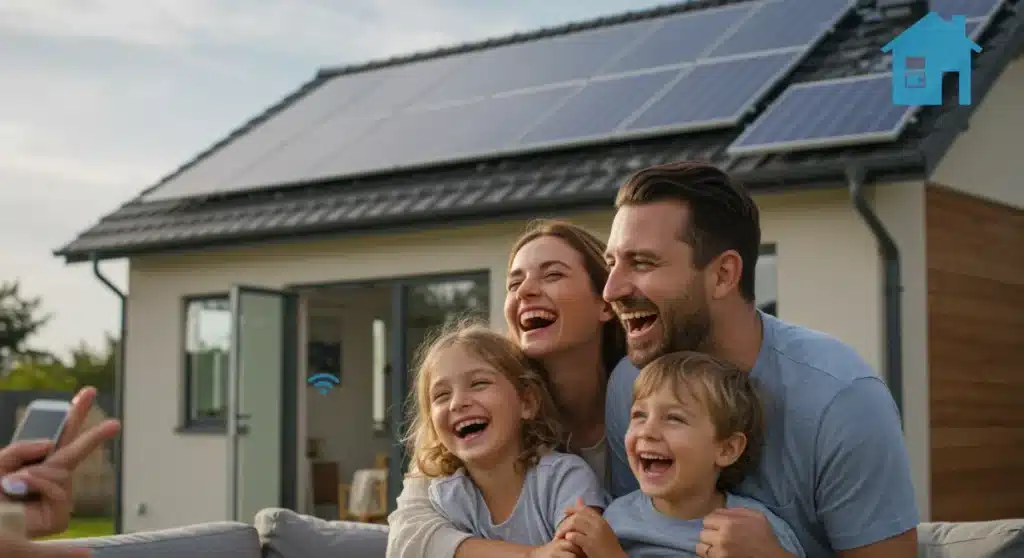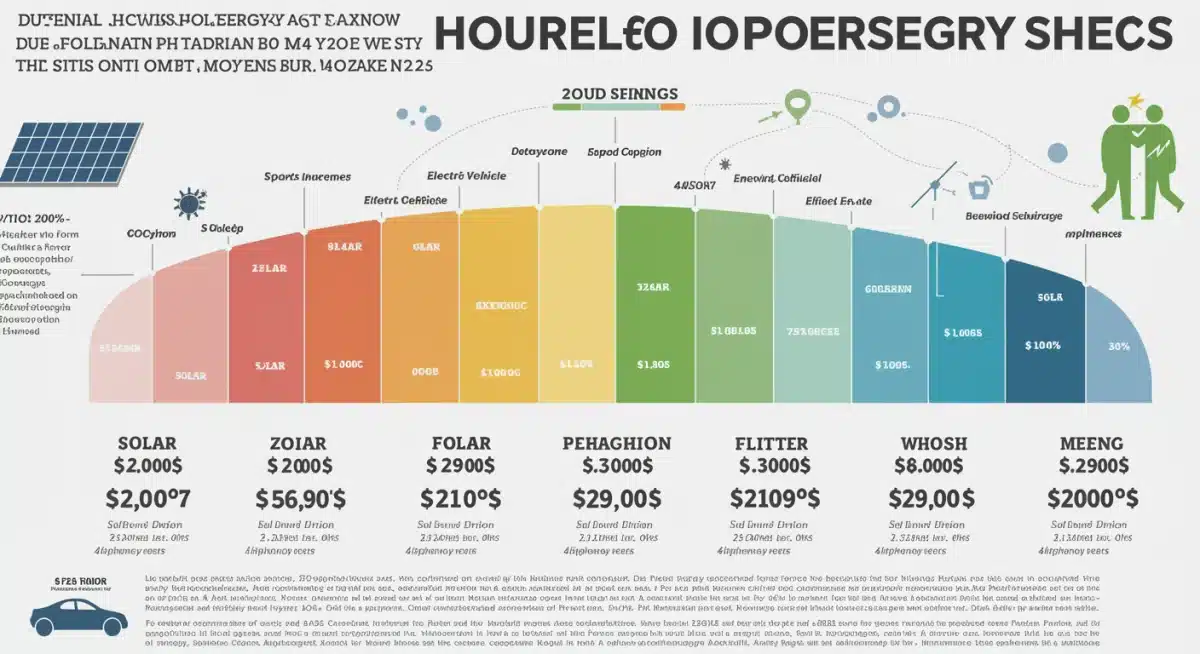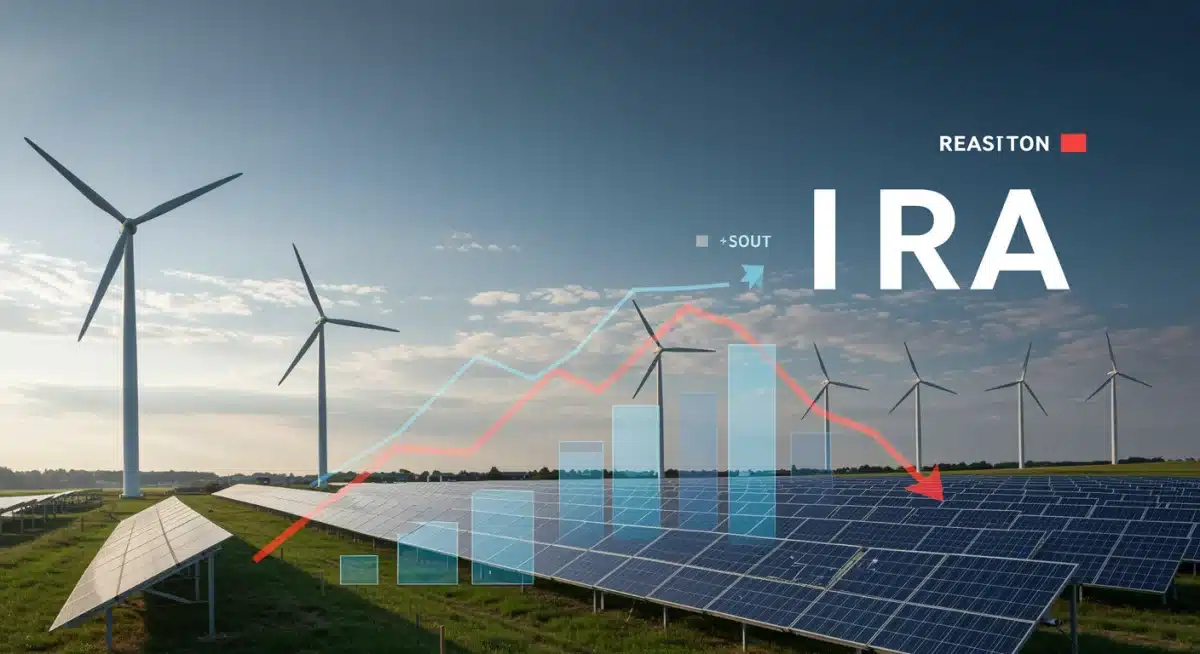IRA 2025 Impact: $500 Annual Energy Savings

The Inflation Reduction Act (IRA) is projected to deliver average annual energy savings of $500 for U.S. households by 2025 through various incentives and clean energy initiatives. This legislation aims to reduce utility bills and promote sustainable living.
IRA 2025 Energy Savings are poised to reshape household budgets across the United States. New analyses and recent updates confirm that the Inflation Reduction Act is on track to deliver significant financial relief, with an average household expected to save approximately $500 annually on energy costs by 2025. This legislation, enacted to combat inflation and promote clean energy, is now showing tangible results and future projections that demand attention from every family managing their finances.
Understanding the Inflation Reduction Act’s Core Energy Provisions
The Inflation Reduction Act (IRA), signed into law in August 2022, represents a monumental commitment to addressing climate change and lowering costs for American families. Its energy-related provisions are extensive, focusing on everything from renewable energy deployment to energy efficiency upgrades for homes. The goal is to incentivize a shift away from fossil fuels and towards cleaner, more affordable energy sources, directly impacting utility bills.
Initially, experts projected various levels of savings, but recent updates have solidified the expectation of substantial household benefits. These provisions include tax credits, rebates, and grants designed to make clean energy technologies more accessible and affordable for homeowners and renters alike. The emphasis is on both immediate and long-term financial relief, coupled with environmental benefits.
Key Programs Driving Energy Savings
- Residential Clean Energy Credit: This extends a 30% tax credit for the cost of new, qualified clean energy property for your home, including solar electricity, solar water heating, wind energy, and geothermal heat pump property. This credit has been a significant driver for solar adoption.
- Energy Efficient Home Improvement Credit: Homeowners can receive tax credits for making energy-efficient improvements such as installing new windows, doors, insulation, and certain energy-efficient heating and cooling systems. These upgrades directly reduce energy consumption.
- High-Efficiency Electric Home Rebate Program (HEEHRP): This program offers point-of-sale rebates for qualifying electrification projects, including heat pumps, heat pump water heaters, and electric stoves. These rebates can cover a significant portion of installation costs, making advanced appliances more affordable.
These programs are not just about reducing carbon emissions; they are explicitly designed to put money back into Americans’ pockets. The average $500 annual saving is a cumulative effect of various measures families can adopt, whether through major installations or smaller, strategic upgrades.
Projected Financial Impact on Households by 2025
The year 2025 is a critical benchmark for the IRA’s energy provisions, as many incentives will have matured and become more widely adopted. Recent analyses from organizations like Rewiring America and the Rocky Mountain Institute indicate that the average U.S. household could indeed see their energy bills drop by around $500 annually. This projection is based on a combination of factors, including increased adoption of energy-efficient technologies and the declining cost of renewable energy.
For single-parent families and those on tight budgets, these savings can be particularly impactful. The IRA aims to democratize access to clean energy benefits, ensuring that lower and middle-income households are not left behind. The financial relief extends beyond just electricity bills, touching upon heating, cooling, and even transportation costs for those who invest in electric vehicles.
How Different Income Brackets Benefit
The IRA’s structure includes provisions specifically tailored to ensure equitable access to these benefits. For instance, some rebates are income-qualified, providing higher incentives for lower-income households. This progressive approach helps alleviate energy burden disparities that often disproportionately affect vulnerable families.
- Low-to-Moderate Income Households: Often eligible for higher rebate amounts and tax credits, potentially covering a larger percentage of upfront costs for upgrades like heat pumps or insulation.
- Middle-Income Households: Can take advantage of significant tax credits for solar installations and energy-efficient appliance upgrades, leading to substantial long-term savings.
- Higher-Income Households: Benefit primarily from the tax credits for larger clean energy investments, such as rooftop solar, that have a quicker payback period due to the incentives.
The critical takeaway is that the IRA is not a one-size-fits-all solution, but a comprehensive package designed to offer financial advantages across the economic spectrum, with a particular focus on reducing the energy burden on families who need it most. The projected $500 saving is an average, meaning many families could save even more, depending on their choices and initial energy consumption.
Recent Updates and Policy Adjustments
Since its enactment, the implementation of the IRA has seen several updates and clarifications from federal agencies, including the Department of Energy (DOE) and the Internal Revenue Service (IRS). These adjustments aim to streamline the application process for tax credits and rebates, making it easier for families to access the promised financial benefits. The DOE, for example, has issued detailed guidance on qualifying products and installation standards, ensuring that investments truly lead to energy efficiency.
The IRS has also provided clearer instructions for claiming tax credits, reducing confusion for taxpayers. These ongoing refinements are crucial for the widespread success of the IRA’s energy programs and directly impact the average savings households can expect. Keeping informed about these updates is essential for maximizing potential benefits.
States are also playing a significant role in enhancing the IRA’s impact. Many states are layering their own incentives on top of federal programs, creating even more attractive financial opportunities for energy efficiency and clean energy adoption. This synergy between federal and state initiatives amplifies the potential for household savings.
Navigating the Rebate and Credit Landscape
The landscape of IRA incentives can appear complex, but resources are continuously being developed to help consumers. Official government websites, non-profit organizations, and energy efficiency contractors are providing tools and guides to help families identify which programs they qualify for and how to apply.
- Official Guidance: Always refer to IRS.gov for the latest tax credit information and Energy.gov for details on rebates and eligible products.
- Local Resources: Many states and local municipalities offer energy audits and assistance programs that can help identify the most impactful upgrades for your home.
- Qualified Professionals: Engaging certified contractors for installations ensures that improvements meet the necessary standards for claiming credits and rebates.
These resources are vital for families looking to take advantage of the IRA. The ongoing updates are designed to clarify and simplify the process, making the average $500 in annual savings an achievable goal for millions of households.
Strategies for Maximizing Your Energy Savings
Achieving the projected $500 in annual energy savings by 2025 requires proactive steps from households. While some savings may accrue passively through broader grid improvements, the most significant benefits come from direct investments in home energy efficiency and clean energy technologies. Strategic planning and informed decision-making are key to unlocking these financial advantages.
Start with an energy audit to identify the most impactful upgrades for your specific home. This can range from simple measures like sealing air leaks and improving insulation to larger investments like installing solar panels or a heat pump. Each improvement contributes to reducing your overall energy consumption and, consequently, your utility bills.
Consider the long-term benefits beyond just the initial savings. Many of these upgrades not only reduce energy costs but also increase home value and improve indoor comfort. The IRA makes these investments more financially viable than ever before, turning what might have been a distant goal into an immediate possibility for many families.
Practical Steps for Homeowners and Renters
- Insulation and Air Sealing: Often the most cost-effective upgrades, these measures prevent heat loss in winter and heat gain in summer, significantly reducing heating and cooling costs.
- Upgrade to Heat Pumps: Replacing traditional HVAC systems with high-efficiency heat pumps can drastically cut energy consumption for heating and cooling, often qualifying for substantial rebates and tax credits.
- Install Solar Panels: The 30% Residential Clean Energy Credit makes solar a highly attractive option for reducing or even eliminating electricity bills.
- Energy-Efficient Appliances: When replacing old appliances, opt for ENERGY STAR certified models, especially for water heaters, refrigerators, and washing machines.
- Electric Vehicles: While a larger investment, federal tax credits for new and used EVs can lead to substantial savings on fuel costs, particularly as charging infrastructure expands.
By implementing a combination of these strategies, families can not only meet but potentially exceed the average $500 annual savings. The IRA provides a robust framework of financial incentives, making it a prime opportunity for households to invest in their energy future.

The Broader Economic and Environmental Benefits
While the direct financial savings for households are a primary focus, the IRA’s energy provisions also yield significant broader economic and environmental benefits. The push towards clean energy is stimulating job growth in manufacturing, installation, and maintenance sectors across the United States. This creates new opportunities for American workers and strengthens local economies.
Environmentally, the reduction in reliance on fossil fuels is directly contributing to a decrease in greenhouse gas emissions. This aligns with national and global efforts to combat climate change, leading to cleaner air and a more sustainable future for generations to come. The IRA represents a holistic approach to national well-being, intertwining financial stability with ecological responsibility.
The long-term economic stability derived from reduced energy price volatility is another key benefit. As more renewable energy sources come online, the grid becomes less susceptible to global fossil fuel market fluctuations, providing more predictable and stable energy costs for consumers over time. This stability is particularly valuable for families budgeting for future expenses.
Community-Level Impact and Investment
- Grid Modernization: Investments in renewable energy infrastructure also contribute to a more resilient and efficient national electrical grid, reducing outages and improving service reliability.
- Local Economic Development: The proliferation of solar farms, wind projects, and energy-efficient manufacturing facilities creates jobs and drives economic activity in communities nationwide.
- Improved Public Health: Reduced air pollution from fossil fuel combustion leads to better public health outcomes, lowering healthcare costs and improving quality of life.
The IRA’s impact extends far beyond individual household savings, creating a ripple effect that benefits communities and the nation as a whole. The average $500 annual saving is a tangible indicator of this larger positive transformation.
Challenges and Considerations for Future Implementation
Despite the promising projections and substantial benefits, the implementation of the IRA’s energy provisions is not without its challenges. Supply chain issues for certain clean energy technologies, the need for a skilled workforce to meet installation demands, and ensuring equitable access across all demographics remain critical considerations. Addressing these hurdles is vital for the IRA to fully realize its potential by 2025 and beyond.
Educating the public about available programs and simplifying the application processes are ongoing efforts. Many households, particularly in underserved communities, may still be unaware of the financial incentives they qualify for or how to access them. Continuous outreach and support are necessary to ensure that the benefits reach everyone intended by the legislation.
Policy stability is also crucial. While the IRA is law, future political shifts could influence the availability or scope of certain programs. Families planning long-term investments should stay informed about any potential legislative changes or new guidance that may emerge.
Addressing Equity and Accessibility
- Targeted Outreach: Programs need to focus on reaching low-income households and communities of color, who often face higher energy burdens.
- Workforce Development: Investing in training programs for clean energy jobs is essential to meet the demand for skilled installers and technicians.
- Streamlined Access: Simplifying application processes and providing clear, multilingual resources can help overcome barriers to participation.
Overcoming these challenges will be key to ensuring that the IRA’s promise of average $500 annual energy savings translates into widespread reality for all American families. The ongoing efforts to refine and improve implementation are critical to this success.

The Long-Term Outlook Beyond 2025
While 2025 marks an important milestone for the IRA’s energy savings, the long-term outlook extends much further. The Act’s incentives are designed to foster sustained growth in the clean energy sector, leading to continued reductions in energy costs and a more resilient energy system for decades to come. The initial savings are just the beginning of a broader transformation.
As technology advances and economies of scale improve, the cost of renewable energy and energy-efficient solutions is expected to continue to decline. This will further enhance the financial benefits for households, even as some of the initial tax credits and rebates may evolve or phase out. The infrastructure built and habits formed now will yield dividends for future generations.
The IRA is setting the stage for a decarbonized economy, where clean energy is not only environmentally preferable but also the most economically sensible choice. This shift will contribute to greater energy independence and security for the United States, insulating families from the volatility of global energy markets.
Sustained Benefits and Future Innovations
- Continued Cost Reductions: Expect ongoing decreases in the cost of solar, wind, and battery storage technologies, making them even more affordable.
- Emerging Technologies: The IRA also supports research and development in areas like advanced geothermal, hydrogen, and carbon capture, which could unlock further energy savings and environmental benefits.
- Grid Resilience: A modernized, decentralized grid powered by diverse clean energy sources will be more resilient to extreme weather events and cyber threats, ensuring more reliable energy supply.
The IRA’s vision for energy savings extends well beyond 2025, creating a pathway to a future where clean, affordable energy is the norm, and average household energy costs are significantly lower than today. This long-term perspective underscores the transformative potential of the legislation for every family.
Key Benefit |
Brief Description > |
|---|---|
Average Savings |
U.S. households projected to save around $500 annually on energy costs by 2025. |
Key Incentives |
Tax credits and rebates for solar, energy-efficient home improvements, and electric appliances. |
Economic Impact |
Job creation, reduced energy price volatility, and increased home values. |
Environmental Benefit |
Significant reduction in greenhouse gas emissions and cleaner air. |
Frequently Asked Questions About IRA Energy Savings
The primary goal is to lower energy costs for American households by promoting clean energy adoption and energy efficiency. It aims to achieve this through a range of tax credits, rebates, and grants, ultimately reducing reliance on fossil fuels and stabilizing utility bills for families across the U.S.
By 2025, the average U.S. household is projected to save approximately $500 annually on energy costs. These savings stem from various incentives, including investments in solar power, energy-efficient home upgrades, and the adoption of electric vehicles and appliances, making energy more affordable.
Qualifying improvements include installing solar panels, upgrading to heat pumps for heating and cooling, improving insulation, replacing windows and doors with energy-efficient models, and purchasing electric appliances like heat pump water heaters. These measures aim to reduce overall energy consumption and costs.
Yes, the IRA includes provisions designed to ensure equitable access, with some rebates and credits offering higher incentive amounts for low-to-moderate income households. This helps offset upfront costs, making energy-efficient upgrades more accessible and reducing the energy burden on vulnerable families.
Families should consult official government websites such as IRS.gov for tax credit details and Energy.gov for information on rebates and qualifying products. Local energy agencies and certified contractors can also provide guidance on specific programs and eligible home improvements, ensuring informed decisions.
What Happens Next
The IRA 2025 Energy Savings trajectory signals a significant shift in household finance and national energy policy. As 2025 approaches, families should actively explore the available incentives and consider strategic energy upgrades. The ongoing implementation and refinement of IRA programs mean that new opportunities and clearer guidance will continue to emerge. Staying informed through official channels and engaging with local energy experts will be crucial for maximizing the financial and environmental benefits, setting a foundation for sustained savings beyond the immediate horizon.





